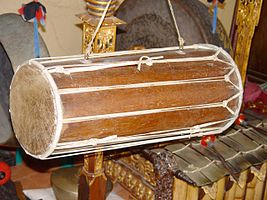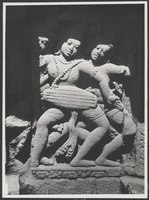Kendang
| Developed | Indonesia[4][5] |
|---|---|

 |
| Music of Indonesia |
| Genres |
|---|
|
| Specific forms |
|
|
|
|
|
| Regional music |
A kendang or gendang (
Overview
The typical double-sided membrane drums are known throughout Maritime Southeast Asia and India. One of the oldest image of kendang can be found in ancient temples in Indonesia, especially the ninth century Borobudur and Prambanan temple.
Among the
Within Gamelan, the kendang is smaller than the bedug, which is placed inside a frame, hit with a beater, but used less frequently. The kendang usually has the function of keeping the tempo (laya) while changing the density (irama), and signaling some of the transitions (paralihan) to sections and the end of the piece (suwuk).
In the dance or
Among the
Kendang making
Good kendang instruments are said to be made from the wood of
The skin is stretched on y-shaped leather or rattan strings, which can be tightened to change the pitch of the heads. The thinner the leather the sharper the sound.
Accompaniments
Javanese
In Gamelan Reog, kendhang are used To accompany the Reog Ponorogo art, the sound produced by Kendhang Reog is very distinctive with the beat of "dang thak dhak thung glhang". The existence of Kendang Reog is currently the largest in the world of the existing types of Kendhang.
In
- Kendhang ageng, kendhang gede (krama/ngoko, similar to gong ageng in usage), or kendhang gendhing is the largest kendang, which usually has the deepest tone. It is played by itself in the kendhang satunggal (lit. "single drum") style, which is used for the most solemn or majestic pieces or parts of pieces. It is played with the kendhang ketipung for kendhang kalih (lit. "double drum") style, which is used in faster tempos and less solemn pieces.
- Kendhang wayang is also medium-sized, and was traditionally used to accompany wayang performances, although now other drums can be used as well.
- Kendhang batangan or kendhang ciblon[7] is a medium-sized drum, used for the most complex or lively rhythms. It is typically used for livelier sections within a piece. The word ciblon derives from a Javanese type of water-play, where people smack the water with different hand shapes to give different sounds and complex rhythms. The technique of this kendang, which is said to imitate the water-play,[8] is more difficult to learn than the other kendang styles.
- Kendhang ketipung is the smallest kendang, used with the kendang ageng in kendhang kalih (double drum) style.
Sundanese
In Sundanese Gamelan, a minimum set consists of three drums.[9]
- Kendang Indung (large drum)
- Kendang Kulanter, two (small drum). Kendang Kulanter is divided into two, namely the Katipung and the Kutiplak.
Many types of Sundanese Kendang are distinguished according to their function in accompaniment :
- Kendang Kiliningan
- Kendang Jaipongan
- Kendang Ketuk Tilu
- Kendang Keurseus
- Kendang Penca
- Kendang Bajidor
- Kendang Sisingaan and others.
Each type of drums in
Balinese
In Balinese Gamelan, there are two kendang:[10]
- Kendang wadon, the "female" and lowest pitched.
- Kendang lanang, the "male" and highest pitched.
Makassarese
Ganrang (Makassarese kendangs) can be divided to three types:[11]
- Ganrang Mangkasarak is the largest drums as a result it is also called Ganrang Lompo (largest drum in Makassarese language).These drums are usually used in important sacred ceremonies such as blessing for sultanate's heirlooms.
- Ganrang Pakarena are usually smaller with diameters measuring in 30–40 cm, which are usually used for Pakarena dance, which used 2-4 drums with differing beats and symbolizes the men's strength and vitality.
- Ganrang Pamancak are usually the smallest with diameters measuring in 20–25 cm, and used as martial arts accompaniments.
Buginese
Among the
- Pammulang patterns are usually the beginning as intro
- Bali Sumange are played afterwards which are usually more energetic
- Kanjara patterns are used afterward, as finale.
Gallery
-
Kendang of Java, one side is bigger than other.
-
Bas-relief of kendang at Prambanan
-
Bas-relief of kendang at Prambanan
See also
Sources
- ^ 10 Alat Musik Kendang: Asal-Usul, Jenis, dan Cara Memainkannya[1]
- ^ Kendang Sunda[2]
- ^ 1994[3]
- ^ "Kendang - Instruments of the world". www.instrumentsoftheworld.com.
- .
- ^ "Kendang".
- ^ https://omeka1.grinnell.edu/MusicalInstruments/exhibits/show/ens/item/82[dead link]
- ISBN 0-19-588582-1. "The technique of kendang ciblon is very difficult to acquire.[who?] Ciblon is the Javanesename for a type of water-play, popular in villages, where a group of people, through smacking the water with different hand-shapes, produce complex sounds and rhythmic patterns. These sounds are imitated on the dance drum."
- ISBN 978-979-8967-50-4.
- ^ "The Instruments for Gamelan Bali". Archived from the original on 2012-11-03. Retrieved 2019-10-20.
- ^ "Gandrang, Alat Musik Tradisional Makassar". 27 May 2015.
- S2CID 226030960.
Further reading
- Sumarsam. Javanese Gamelan Instruments and Vocalists. 1978–1979.







